Super User
Addverb and Element Logic announce strategic partnership for synergies in warehouse automation
Addverb, a global robotics company providing complete end-to-end warehouse automation solutions, announces a strategic partnership with Element Logic, a warehouse optimization provider, and the world's first and largest AutoStore™ partner.
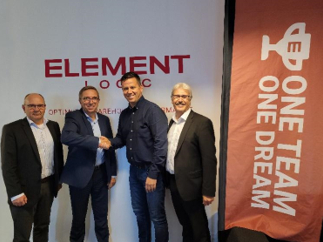 “We are thrilled to enter into this partnership with Element Logic and are proud to work together with such a prestigious player of the industry renowned across Europe and globally,” said Pieter Feenstra, Addverb’s CEO of the EMEA region. "Our ability to serve the market demand will exponentially increase, offering access to a complete automation solution combining AutoStore systems and Addverb’s Mobile Robots. We believe the strong portfolio, innovation expertise, and depth of resources we are bringing together through this partnership will allow us to create even more value for our customers.”
“We are thrilled to enter into this partnership with Element Logic and are proud to work together with such a prestigious player of the industry renowned across Europe and globally,” said Pieter Feenstra, Addverb’s CEO of the EMEA region. "Our ability to serve the market demand will exponentially increase, offering access to a complete automation solution combining AutoStore systems and Addverb’s Mobile Robots. We believe the strong portfolio, innovation expertise, and depth of resources we are bringing together through this partnership will allow us to create even more value for our customers.”
Addverb offers a unique logistics combination of fixed and mobile automation and advanced warehouse software solutions. Their expertise involves providing end-to-end warehouse automation solutions based on Industry 4.0, IoT, and robotics. Addverb has provided solutions to customers in various industries such as Unilever, Flipkart, Amazon, PepsiCo, Coca-Cola, Dabur, Johnson & Johnson, and more.
“This partnership will spark the ability to create use-cases around AutoStore projects, which will turn around a better ROI for customers and have less dependency on the scarce labor,” said Hans-Jörg Braumuller, Group Design & Consulting Director at Element Logic. “At Element Logic, our global expansion is happening at an exciting rate and Addverb will be a part of that. We’re looking forward to working with them to make for more flexible warehouse automation technology.”
Element Logic® has been optimizing warehouse performance since 1985. It is the world’s first, and largest AutoStore® partner. Element Logic specializes in storage and retrieval, unit fulfilment systems, and designing and installing tailor-made solutions that streamline the customers’ workflow. Headquartered in Norway, Element Logic provides robotic solutions and software that improve companies’ value chains in a wide variety of industries. The partnership follows an extensive and lengthy analysis of Addverb’s technology, functionality, and way of working, and provides the opportunity for both parties to create use cases around AutoStore projects.
UK Manufacturing PMI – Government intervention only answer to restore competitiveness of UK manufacturing – MHA Comments
Following the release of the UK manufacturing PMI this morning (1 November), Chris Barlow, Partner at MHA, says the government must intervene more, not less, to restore the country’s competitiveness that has been battered by ongoing political turmoil:
“Despite numerous U-turns on recent economic measures from the new Chancellor in an attempt to establish economic stability, UK manufacturers continue to be crippled by longstanding issues including labour and skill shortages, supply chain issues, rising inflation and eye-watering energy prices.
 “These have been exacerbated by the lack of stability and diminished confidence caused by the UK’s political turmoil in October, which has severely damaged the sector’s competitiveness within Europe and beyond. While manufacturers broadly welcomed the government’s 6 months of support against the spiralling energy costs, competitors such as Germany have unveiled energy support packages running until 2024. The government’s short-sighted approach, combined with the now reinstated rises to Corporation Tax, have seen the UK become a far less attractive place to invest and do business.
“These have been exacerbated by the lack of stability and diminished confidence caused by the UK’s political turmoil in October, which has severely damaged the sector’s competitiveness within Europe and beyond. While manufacturers broadly welcomed the government’s 6 months of support against the spiralling energy costs, competitors such as Germany have unveiled energy support packages running until 2024. The government’s short-sighted approach, combined with the now reinstated rises to Corporation Tax, have seen the UK become a far less attractive place to invest and do business.
“The government must intervene to restore competitiveness and rebuild manufacturers’ confidence to invest. While permanently setting the Annual Investment Allowance at £1 million from April 2023 is a welcome step, this alone will not provide manufacturers with the confidence to invest in the long term, overcome current economic pressures and drive the country towards net zero by 2050.
“The Chancellor must seize the moment and use the upcoming fiscal statement on 17 November to provide new tax incentives to stimulate greater sector investment and drive productivity improvements. The government should also work alongside the Bank of England to reduce interest rates and drive more spending to support vital services. The pressures of inflation are largely driven by oil and gas prices, meaning interest rate rises will not dampen their impact. It is therefore vital for the government to intervene more and not less, to affect the markets and make the country an attractive place to do business again.
About MHA
MHA is a network ranked the 12th largest accountancy group in the UK. It comprises of 19 offices nationwide with a strong reputation for specialist industry knowledge and that collaborate and share best practice to provide outstanding client service. The network has 106 partners and 1152 staff across the UK.
MHA is the UK independent member of Baker Tilly International, one of the world’s largest leading international networks of independently owned and managed accountancy and business advisory firms, operating across 148 territories.
* https://www.accountancyage.com/rankings/top-5050-accountancy-firms-2021/
Alfa Laval supplies heat exchangers to the world’s largest green hydrogen plant
Alfa Laval has signed an agreement to deliver compact heat exchangers to the world’s largest green hydrogen plant, which is to be constructed in the Middle East. The facility, powered by renewable energy, will be part of the city of Neom, built from scratch in the northwestern desert, with the ambition of establishing a new model for sustainable living.
According to International Energy Agency (IEA), hydrogen is one of the leading options for storing energy from renewables during days, weeks or even months, and it enables transportation over long distances. However, green hydrogen production has its challenges. When purified water is split into hydrogen and oxygen using renewable electricity, it is crucial to keep a stable temperature in the electrolyser to maximize efficiency. Splitting water into the two gases generates excess heat which needs to be constantly cooled off. In this project it is done by using Alfa Laval energy efficient plate heat exchangers.
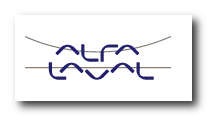 Alfa Laval is a leading supplier of heat exchangers to many of the main electrolyser manufacturers.
Alfa Laval is a leading supplier of heat exchangers to many of the main electrolyser manufacturers.
Neom’s location and infrastructure will allow the generation of 4 GW of renewable power from solar and wind where the green hydrogen production facility will use about half of it. It will be the largest green hydrogen plant and the first installation of gigawatt size, producing 650 tons of hydrogen per day. This in turn will be used to produce 1.2 million tons of green ammonia annually.
“Our business within hydrogen has developed well over the past years and we are today supplying efficient heat exchangers to the various steps of the process; for production, distribution and use,” says Thomas Møller, President of the Energy Division at Alfa Laval. “With our products and expertise, we will continue to be part of accelerating and scaling this area, which is so important in the race to net zero emission.”
Did you know that… The IEA expects the total hydrogen demand from industry to expand 44 percent by 2030, with clean hydrogen becoming increasingly important – and rapid actions are needed in the next 10 years to meet this demand.
This is Alfa Laval
Alfa Laval is a world leader in heat transfer, centrifugal separation and fluid handling, and is active in the areas of Energy, Marine, and Food & Water, offering its expertise, products, and service to a wide range of industries in some 100 countries. The company is committed to optimizing processes, creating responsible growth, and driving progress to support customers in achieving their business goals and sustainability targets.
Alfa Laval’s innovative technologies are dedicated to purifying, refining, and reusing materials, promoting more responsible use of natural resources. They contribute to improved energy efficiency and heat recovery, better water treatment, and reduced emissions. Thereby, Alfa Laval is not only accelerating success for its customers, but also for people and the planet. Making the world better, every day.
Alfa Laval has 17,900 employees. Annual sales in 2021 were SEK 40.9 billion (approx. EUR 4 billion). The company is listed on Nasdaq Stockholm.
Brenntag Specialties becomes exclusive distributor for INOFEA services in EMEA
Brenntag, the global market leader in chemicals and ingredient distribution, has just announced an exclusive partnership with INOFEA to promote the pharmaceutical applications of its enzyme technology in EMEA.
As part of the exclusive partnership, Brenntag and INOFEA will provide support and services to enable customers to get the most out of INOFEA’s technology in their applications, such as protecting and enhancing the performance of their enzymes. Brenntag will leverage its global reach to promote INOFEA’s products and services within the pharmaceutical industry, including the manufacturers of APIs, biosimilars, intermediates, diagnostics and medical devices.
 INOFEA has developed the enzzen® technology, enhancing enzyme stability, enabling recyclability and easy recovery in manufacturing steps. Enzymes earn a broader substrate range and achieve extraordinary reactivity by enhancing reaction rate and selectivity. Thus, customers need less raw materials for synthesis, less energy during the production process and can benefit from lower waste production and solvents used in biocatalytic processes.
INOFEA has developed the enzzen® technology, enhancing enzyme stability, enabling recyclability and easy recovery in manufacturing steps. Enzymes earn a broader substrate range and achieve extraordinary reactivity by enhancing reaction rate and selectivity. Thus, customers need less raw materials for synthesis, less energy during the production process and can benefit from lower waste production and solvents used in biocatalytic processes.
“Working with INOFEA we are able to offer our pharmaceutical customers an innovative solution that can fulfil important sustainability requirements for future production processes,” comments Joakim Volke, President of Pharma EMEA. “Brenntag Specialties is excited to expand our service offerings with the enzzen®-enzymes, which is becoming part of our Green Alternatives Portfolio.”
Anne Timm, CEO of INOFEA: “We found an ideal partner in Brenntag to promote our technology to the pharma market in EMEA. As a company providing highly innovative solutions it is a big challenge to have our technology properly marketed and promoted within such a big and diversified market. We are sure Brenntag's huge and technically proficient resources will turn our potential into high-level opportunities, and this is only the first step of a very long-term and mutually profitable partnership.”
About INOFEA:
INOFEA, a biotech enterprise founded in Switzerland in 2014, is an enzyme-performance-improving company enabling sustainable manufacturing processes going hand in hand with a reduction of waste, pollution, and material consumption. INOFEA unfolds the potential of enzymes in biocatalysis and medical applications. The offerings include, among other activities, customized development of enzymes with superior properties focusing on the growing importance of defossilization in Life-Science industries. INOFEA enables the industry to make production of APIs economically and environmentally more sustainable, by reducing the number of intermediates versus chemical synthesis resulting in less waste, energy consumption and purification steps. The company has supply and licensing agreements in place and invests further into biocatalysis enabling customers reaching their ambitious sustainability goals.
About Brenntag:
Brenntag is the global market leader in chemicals and ingredients distribution. The company holds a central role in connecting customers and suppliers of the chemical industry. Headquartered in Essen, Germany, Brenntag has more than 17,000 employees worldwide and operates a network of about 700 sites in 78 countries. In 2021, Brenntag generated sales of around 14.4 billion EUR. The two global divisions, Brenntag Essentials and Brenntag Specialties, provide a full-line portfolio of industrial and specialty chemicals and ingredients as well as tailor-made application, marketing and supply chain solutions, technical and formulation support, comprehensive regulatory know-how, and digital solutions for a wide range of industries. In the field of sustainability, Brenntag pursues specific goals and is committed to sustainable solutions in its own sector and the industries served. Brenntag shares have been listed at the Frankfurt Stock Exchange since 2010, initially in the MDAX and since September 2021 in the DAX. In addition, the Brenntag SE shares are listed in the DAX 50 ESG and DAX ESG Target. For more information, visit www.brenntag.com
Metso Outotec to deliver world’s largest capacity flash smelting furnace to a copper producer in Africa
Kamoa Copper S.A. has selected Metso Outotec to supply a high-capacity Direct Blister Furnace to the company’s copper mining complex expansion in the Democratic Republic of Congo. The value of this type of a delivery is typically between EUR 30 to 40 million. The order has been booked in Metals’ third-quarter orders received.
“Non-ferrous metals play a key role in the green transition, and a major increase in global copper production is required to support this transition. We are pleased to support Kamoa Copper in their ambitious expansion project, in which high capacity and reliable, sustainable processes play a vital role. Our collaboration has been excellent throughout the initial stages of the process, including the initial study work, basic engineering as well as pilot testing,” Jyrki Makkonen, Vice President, Smelting at Metso Outotec.
Metso Outotec’s scope of delivery consists of key equipment and automation for the Direct Blister Furnace designed for the production of blister copper in a single flash furnace without the need for separate converting stages. The 500 ktpa copper throughput furnace will have the largest licensed flash smelting capacity in the world. The scope also includes intelligent safety and monitoring automation systems for the furnace.
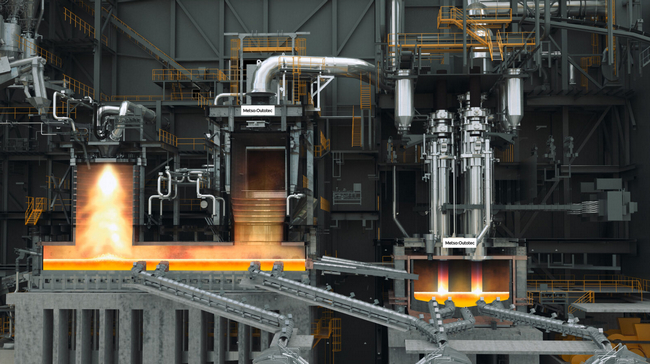
Metso Outotec has delivered more than 60 flash furnaces around the world since the 1950s. This is the most utilized technology in pyrometallurgical copper production. The Metso Outotec Flash Smelting Process is the cleanest smelting method available and part of the company’s Planet Positive offering.
More information about the Metso Outotec Direct Blister Process is available on our website.
Metso Outotec is a frontrunner in sustainable technologies, end-to-end solutions and services for the aggregates, minerals processing and metals refining industries globally. By improving our customers’ energy and water efficiency, increasing their productivity, and reducing environmental risks with our product and process expertise, we are the partner for positive change. Metso Outotec is committed to limiting global warming to 1.5°C with Science Based Targets.
Headquartered in Helsinki, Finland, Metso Outotec employs over 15,000 people in more than 50 countries and its sales for 2021 were about EUR 4.2 billion. The company is listed on the Nasdaq Helsinki. mogroup.com
Ocergy foundation technology selected for Salamander pre-FEED
The Salamander floating offshore wind project, a joint venture between Simply Blue Group, Ørsted and Subsea7, has awarded the pre-FEED foundation design to Ocergy for its OCG-Wind foundation technology.
Last year, Salamander signed a memorandum of understanding (MoU) with Ocergy to evaluate its foundation design for the development in north east Scotland. The project will be a contributor to ensuring the UK government’s target of delivering 5GW of operational floating offshore wind by 2030.
Ocergy has developed OCG-Wind, a novel and efficient floating wind turbine foundation, to support very large wind turbines (>10MW), designed for development of large-scale wind farms. It is targeting a levelised cost of energy (LCOE) that can start to drive reductions in floating offshore wind farms to eventually be competitive with fixed offshore wind farms.
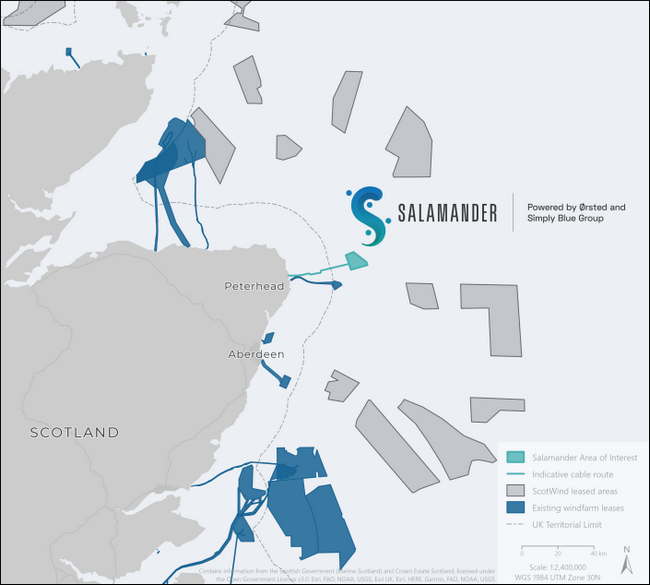
OCG-Wind is a semi-submersible platform designed to utilise the industrial performance of the hull fabrication and assembly through the maximisation of the local supply chain. The hull is made of three outside circular columns connected mechanically with trusses to a central column that supports the wind turbine.
A feasibility study considered all aspects of the design, technical performance, fabrication, assembly, operations and installation of the OCG-Wind for Salamander. It also reviewed the compatibility of the OCG-Wind platform to the site, inclusive of performance, and supply chain and local content management, as well as identified schedule risks and overall project costs. This feasibility study will now progress to pre-FEED phase.
Huw Bell, Salamander Project Director said: “From inception, the foundation manufacturing and assembly was a crucial element for us in delivering higher local content. We’re focusing on the capabilities of the Scottish supply chain, which is helping us in deciding which technologies to advance. Ocergy’s OCG-Wind technology meets our requirements.
“We aim to provide access to double the number of Scottish port facilities over some traditional floating concepts due to lower draft requirements. We also expect a scalable fabrication and assembly process, suitable for commercial scale deployment as well as decreasing fabricated steel mass by around a third, which will reduce the cost of energy whilst also providing potential for local fabrication.”
Dominique Roddier, Ocergy’s CEO said: “The Salamander project is of paramount importance for our consortium and the floating offshore wind industry. This project will demonstrate that the premise of delivering one unit per week, week after week is achievable. This is the last major industry hurdle before the deployment of large, commercial-scale, floating wind projects.”
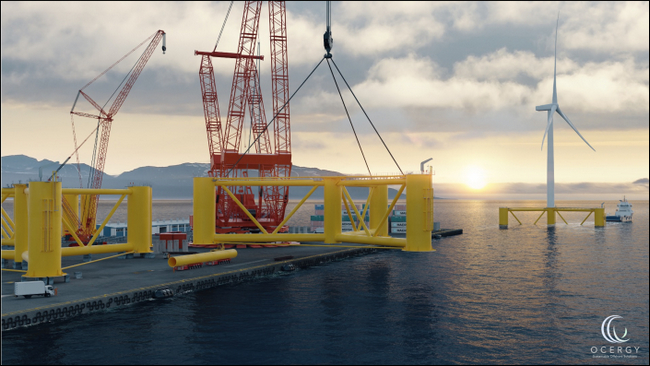
Salamander, located 35km off Peterhead, is designed to provide the Scottish supply chain with an early capacity development opportunity, enabling it to play a much greater role in subsequent large-scale floating offshore wind buildout. The project will deploy innovative and cutting-edge floating offshore wind technologies to support the cost reduction and learning journey needed for the commercial deployment of floating offshore wind.
Salamander is intended to be progressed through the innovation track of Crown Estate Scotland’s Innovation and Targeted Oil and Gas (INTOG) leasing round. The INTOG round will grant seabed leases through an auction process, which will be split into two pots – one for smaller scale innovation projects of less than 100 MW and one for larger projects linked to oil and gas infrastructure.
About Salamander Floating Offshore Wind
The 100MW Salamander floating wind project, a joint venture between Simply Blue Group, Ørsted and Subsea7, will be a major contributor to ensuring the UK government’s target of delivering 5GW of operational floating offshore wind by 2030 is both achievable and to the maximum benefit of public and private stakeholders.
The pioneering project, located 35km off Peterhead in the East Coast of Scotland, is designed to provide the Scottish supply chain with an early capacity development opportunity, enabling it to play a much greater role in subsequent large-scale floating offshore wind buildout. The project will deploy innovative and cutting-edge floating offshore wind technologies to support the cost reduction and learning journey needed for the commercial deployment of floating offshore wind.
About Ocergy
Ocergy is a technology company developing two sustainable offshore solutions:
OCG-Wind is a low-cost foundation supporting the new generation of very large offshore wind turbines. The innovative hull allows the platform to have a very light weight, a necessity to reduce LCOE. It is tailored towards ease of industrialization, to bring flexibility in fabrication and increase the use of a local supply chain in the project fabrication life cycle.
OCG-Data is an innovative multi-disciplinary ocean observer for complete offshore site assessment. It has enough footprint to host and power multiple instrumentation packages for resource and environmental characterization. Underwater biodiversity monitoring relies on the combination of restoration technologies and passive acoustic monitoring arrays. The buoy also hosts a bird and bat detection and identification system. OCG-Data provides high-quality data including ecological information for stakeholders’ engagement.
Mitsubishi Electric’s solutions under the spotlight at Robotics and Automation 2022
Mitsubishi Electric will exhibit its comprehensive range of robots on stand 220 at Robotics and Automation, from 1st-2nd November 2022 in Coventry. During the event, visitors can learn more about how the different solutions address a variety of operational requirements and help to improve productivity.
Robotics and Automation is a key exhibition in the robotics event calendar. Visitors have the opportunity to explore how the latest automated technologies can boost efficiency, profitability and ultimately provide a competitive advantage. As a global leader in the sector with a proven track record of supporting breakthrough robot and automation projects, Mitsubishi Electric will contribute to the discussion.
Visitors to the company’s booth will be able to interact with three different robotic applications, each one demonstrating the capabilities of distinct assemblies. More precisely, attendees will be invited to play dice with a MELFA Assista collaborative robot (cobot). Using an integrated gripper and vision system, the machine picks up a dice, rolls it and records the score obtained. It then lets its human opponent do the same and then determines which party had the highest score. If its competitor is the winner, it releases a prize.
Also a compact RH-CH SCARA, and a vertical RV series six-axis arm will be in operation, reporting key operational information on stand. To do so, they will be connected to Mitsubishi Electric’s PLCs and GOT 2000 HMIs. The machines will be equipped with the MELFA SafePlus safety solution, which enables any of the company’s robots to work in close proximity with humans, following cooperative and collaborative practices.
![Visitors to the Mitsubishi Electric’s booth will be able to interact with three different robotic applications [Source: Mitsubishi Electric Europe B.V.]](/images/news/Technology/2022-10-31_093831.jpg) Visitors to the Mitsubishi Electric’s booth will be able to interact with three different robotic applications [Source: Mitsubishi Electric Europe B.V.]
Visitors to the Mitsubishi Electric’s booth will be able to interact with three different robotic applications [Source: Mitsubishi Electric Europe B.V.]
Barry Weller, Robotics Product Manager at Mitsubishi Electric, comments: “We look forward to showcasing our broad portfolio of solutions at Robotics and Automation. When it comes to automating key processes and operations, one size rarely fits all. Our range was developed to address the needs of industry and to help companies succeed in their digital transformation journeys. We invite anyone looking for a robotic system to visit our experts on stand – we will be able to guide you through the selection process and help to identify the most suitable products for your specific applications.”
Visit Mitsubishi Electric on stand 220 at Robotics and Automation, taking place on 1st-2nd November 2022 at Coventry Building Society Arena, Coventry: https://www.roboticsandautomation.co.uk/
About Mitsubishi Electric
With more than 100 years of experience in providing reliable, high-quality products, Mitsubishi Electric Corporation (TOKYO: 6503) is a recognized world leader in the manufacture, marketing and sales of electrical and electronic equipment used in information processing and communications, space development and satellite communications, consumer electronics, industrial technology, energy, transportation and building equipment. Mitsubishi Electric enriches society with technology in the spirit of its “Changes for the Better.” The company recorded a revenue of 4,476.7 billion yen (U.S.$ 36.7 billion*) in the fiscal year ended March 31, 2022.
Mitsubishi Electric Europe, Industrial Automation – UK Branch is located in Hatfield, United Kingdom. It is a part of the European Factory Automation Business Group based in Ratingen, Germany which in turn is part of Mitsubishi Electric Europe B.V., a wholly owned subsidiary of Mitsubishi Electric Corporation, Japan.
The role of Industrial Automation – UK Branch is to manage sales, service and support across its network of local branches and distributors throughout the United Kingdom.
*U.S. dollar amounts are translated from yen at the rate of ¥221=U.S.$1, the approximate rate on the Tokyo Foreign Exchange Market on March 31, 2022.
Further Information:
Website: gb.mitsubishielectric.com/fa
Europe’s vibrant plastic sector is prominent conference topic
Although challenged by high energy costs, recyclers in Europe will talk about a higher-volume future at Paper & Plastics Recycling Conference Europe in Rotterdam.
Investments in established and emerging plastic recycling and reprocessing techniques will be a focal point of discussion at the 2022 Paper & Plastics Recycling Conference Europe event, which takes place at the Rotterdam Hilton 15-16 November.
While paper and board recycling contributes to some program topics, other sessions at the two-day conference https://paperplasticseurope.recyclingtodayevents.com/schedule/ will cast the spotlight on plastic scrap collection, processing, trading and consumption.
High energy costs have caused concerns for a difficult winter for some recyclers in Europe. Companies with long-term plans designed to meet Europe’s aggressive plastic recycling targets, however, will find numerous other topics of discussion in Rotterdam.
On Tuesday, 15 November a session titled “Plastic: A Scramble To Close Loops” will examine the investments being made in the new decade to boost the recycling rate of plastic in Europe, with recyclers on the front line of that effort participating in the conversation.

Panelists at the Tuesday afternoon session include Ben Kras of Netherlands recycling firm Kras Recycling BV; Max Craipeau of Greencore Resources Limited, which operates plastic recycling facilities in Poland and Indonesia; Jacob Rognhaug of global plastic sorting and recycling technology provider TOMRA; and Jan-Willem Muller, a managing partner in plastics recycling funding group Infinity Recycling. The session will be moderated by Martijn Reintjes, chief editor of the Recycling International publication.
The next day, a 90-minute discussion between participants on the “R-Polymer Consumer Panel” will focus on emerging supply and demand dynamics in an era of growing mechanical and chemical plastics recycling activity in Europe.
Buyers and reprocessors of plastic scrap at the Wednesday, 16 November session include: James Marshall of United Kingdom-based Fiberight Limited; Jeremy (Jez) Blake of United Kingdom-based Berry Circular Polymers; Salvis Lapiņš of Latvia-based PET Baltija; and Samuel Martinez of United Kingdom-based Greenback Recycling Technologies Ltd. The discussion will be moderated by DeAnne Toto, editorial director of the Recycling Today Media Group.
Several of the conference’s other five sessions touch on issues of interest to plastic recyclers, including the regulatory climate in Europe (“Recycling’s Role In The Green Deal,” 15 November); trade issues affecting the movement of scrap materials (“Walls And Bridges: Trade In The 2020s,” 15 November); and the sustainability movement in the packaging sector (“Sector Analysis: Packaging,” 15 November).
More information on the November Paper & Plastics Recycling Conference Europe event, including how to register https://gie.expoplanner.com/?do=reg.flow&event_id=36 , can be found on this web page. https://paperplasticseurope.recyclingtodayevents.com/
PulPac expands patent portfolio with new bottle innovations for Dry Molded Fiber
With one new patent application filed last week, and one more patent granted in Japan, PulPac continues to expand the Dry Molded Fiber patent portfolio. The new grant and application both cover Dry Molded Fiber bottles, an exciting application that has already been produced on a lab scale.
Dry Molded Fiber is invented, patented, and licensed to packaging manufacturers by PulPac. The game-changing technology is up to ten times faster than traditional fiber forming methods and offers highly competitive unit economics. In addition, it saves significant amounts of valuable water and energy, resulting in up to 80% lower CO2 footprint compared to alternatives.
The granted patent in Japan covers both bottle-forming and more traditional single use objects traditionally made by plastics and wet forming. It is a divisional application from an earlier application granted in Japan. In short, the granted claims describe a cellulose blank containing less than 45 weight percent water being arranged and formed in a forming mould, using heat and isostatic pressure. Just as in other important jurisdictions, further divisional applications will be filed. The new patent application filed also covers manufacturing of bottles, but in a continuous manufacturing line.
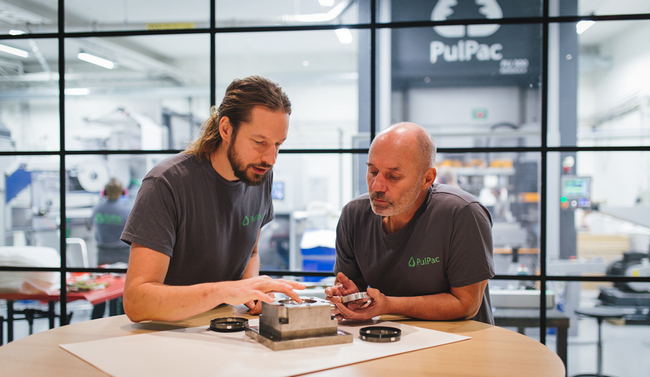 CIPO, Peter Ekwall, continously harvests new innovations together with PulPac's engineers to push the Dry Molded Fiber technology forward and speed up the transition to sustainable fiber-based alternatives and away from single-use plastics.
CIPO, Peter Ekwall, continously harvests new innovations together with PulPac's engineers to push the Dry Molded Fiber technology forward and speed up the transition to sustainable fiber-based alternatives and away from single-use plastics.
“The world consumes massive amounts of plastic bottles, and they are a big contributor to plastic pollution. Only around 30-40% of all plastic bottles across the EU and US, are collected for recycling today. For paper and cardboard packaging, the average is about 80%. Even if our present focus is replacing the single-use products that are industrially ready, bottles are an interesting application for Dry Molded Fiber. We made the first bottles in our lab already in 2018 and some of our early patents are related to bottles,” says Peter Ekwall, CIPO
PulPac now holds 32 patent families with more than 150 granted national patents and plus 60 pending patent applications. New patent applications are filed continuously. In addition, PulPac has a substantive body of know-how and attached trade secrets that are shared within the Dry Molded Fiber network. Based on the core IP, PulPac has developed a complete technology platform covering multiple areas of fiber application manufacturing. All driven by the need of technical solutions for a greener, cleaner world.
About PulPac
PulPac provides the packaging industry with a groundbreaking manufacturing technology for low-cost, high-performance fiber-based packaging and single-use products. By pioneering the technology of cellulose molding PulPac enables their customers to replace single-use plastics with a sustainable and cost competitive alternative globally. For additional information about PulPac, please visit www.pulpac.com or follow us on social media.
Dry Molded Fiber
Dry Molded Fiber, invented and patented by PulPac, is a manufacturing technology designed for the circular economy – using renewable pulp and cellulose resources to produce low cost, high performance, fiber-based packaging, and single-use products. Dry Molded Fiber gives up to 80% lower CO2 footprint at similar cost as plastic. It is up to ten times as efficient as conventional fiber molding invented over 100 years ago. The dry process also saves massive amounts of valuable water resources. In addition, energy savings are significant - as the molded products need no drying.
Carbon capture in the steel industry: ArcelorMittal, Mitsubishi Heavy Industries Engineering, BHP and Mitsubishi Development sign collaboration agreement
ArcelorMittal, the world’s leading global steel and mining company, Mitsubishi Heavy Industries Engineering (MHIENG), a pioneer in carbon capture technology, leading global resources company, BHP, along with Mitsubishi Development Pty Ltd are collaborating on a multi-year trial of MHIENG’s carbon capture technology with ArcelorMittal, following the signing of a funding agreement between the parties.
The companies will also conduct a feasibility and design study to support progress to full-scale deployment.
The agreement, which involves a trial at ArcelorMittal’s steel plant in Gent, Belgium and another site in North America, brings together the expertise of the various partners in identifying ways to enhance carbon capture and utilisation and/or storage (CCUS) technologies in the hard-to-abate steelmaking industry. The industry is estimated to account for around seven-to-nine per cent of global greenhouse gas (GHG) emissions. CCUS has the potential to be a key technology for reducing emissions from existing global blast furnaces, which are anticipated to remain a significant portion of steel production over the coming decades. The IEA estimates CCUS technology needs to apply to more than 53 per cent of primary steel production by 2050, equivalent to 700 Mtpa of CO2, for the Net Zero Emissions scenario.
There are no full-scale operational CCUS facilities in blast furnace steelmaking operations at present, with only a limited number of small-capacity carbon capture or utilisation pilots underway or in the planning phases globally. However, later this year ArcelorMittal Gent will commission its Steelanol project, a scale demonstration plant that will capture carbon-rich process gases from the blast furnace and convert them into ethanol.
To further understand how carbon capture technology can be incorporated into existing steel plants, ArcelorMittal is facilitating the trial at its five million-tonnes-a-year steel plant in Gent, Belgium, and at another location in North America, with MHIENG supplying its proprietary technology and supporting the engineering studies. BHP and Mitsubishi Development, as key suppliers of high-quality steelmaking raw materials to ArcelorMittal’s European operations, will fund the trial that is anticipated to run for multiple years. In Gent, the trial will have two phases. The first phase involves separating and capturing the CO2 top gas from the blast furnace at a rate of around 300kg of CO2 a day – a technical challenge due to the differing levels of contaminants in the top gas. The second phase involves testing the separation and capture of CO2 from the off-gases in the hot strip mill reheating furnace, which burns a mixture of industrial gases including coke gas, blast furnace gases and natural gas.
The parties plan to install the mobile test unit in one of ArcelorMittal’s North American Direct Reduced Iron (DRI) plants, to test MHIENG’s technology in this steelmaking route.
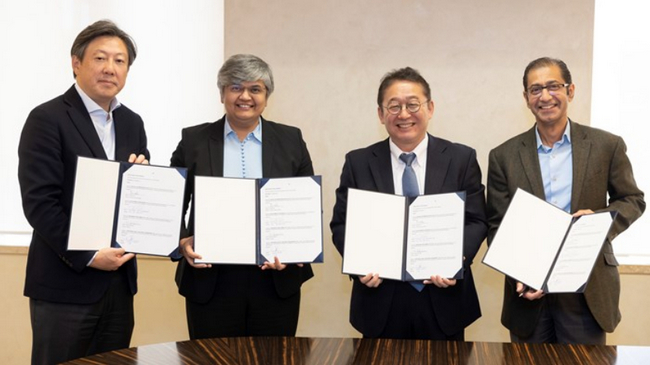
ArcelorMittal Belgium’s Chief Executive Officer, Manfred Van Vlierberghe, said: “The decarbonisation of the steel industry is a huge challenge that we cannot solve alone: it is through pan-industry partnerships and collaboration that we will achieve ArcelorMittal’s climate goals of reducing CO2 emissions by 35 per cent by 2030 in Europe, and by 30 per cent by 2030 worldwide. Alongside our continued energy efficiency improvements, we are developing two routes to decarbonize steelmaking: Smart Carbon and Innovative-DRI. Both routes will contribute in our journey to deliver carbon-neutral steelmaking. The Smart Carbon route also allows us to integrate carbon capture and re-use (CCU) or storage (CCS) technologies, capturing carbon emitted during the steelmaking process. We are therefore proud to be working with BHP, Mitsubishi Development and Mitsubishi Heavy Industries Engineering on this pioneering Carbon Capturing pilot project, in ArcelorMittal Gent.”
Carbon capture activities are the largest cost component of the CCUS value chain and represent roughly two-thirds of the total capital cost and are the greatest consumer of additional energy. Improved understanding of carbon capture technology performance, cost, risk and sustainability outcomes are essential to determine its role in efforts to decarbonise the steel industry.
This latest collaboration marks a critical milestone in BHP’s strategy to support decarbonisation efforts in steelmaking, which aims to achieve coverage of geographically diverse customer markets and potential technology pathways and follows partnerships in recent years with other global majors POSCO, China Baowu, JFE Steel, HBIS Group and TATA Steel. Collectively with ArcelorMittal, these companies account for more than 17 per cent of reported global steel production.
BHP’s Chief Commercial Officer, Vandita Pant, said: “There is currently no certain or single pathway to net zero for steelmaking. CCUS is one of the key abatement technologies with the potential to support the development of some of those pathways, so working with industry leaders like ArcelorMittal, Mitsubishi Development and MHIENG, we hope to arrive at scalable solutions more quickly to help reduce carbon emissions in steelmaking.” Steel is a critical product for the world to develop and decarbonise, and we must work hard, together, to enable lower GHG emissions steel, support the reduction of carbon intensity in the blast furnace and test new technologies for steel production,” she added.
Mitsubishi Development’s Managing Director and Chief Executive Officer, Sadahiko Haneji said the company will continue to fulfil its responsibility as an active player in relevant industries to contribute towards achieving a carbon-neutral society. “Mitsubishi Development recognizes that as an industry we have to collaborate to establish carbon capture trials that can be used as a stepping stone to progress technological advancement and build the industry’s confidence to reduce carbon emissions,” said Mr Haneji. By participating in these trials, we are demonstrating a commitment to growing climate technologies and reducing our carbon footprint in ways that will not compromise our quality of life,” he added.
MHIENG has been developing its proprietary KM CDR ProcessTM for CO2 capture in collaboration with Kansai Electric Power since 1990 and, as of October 2022, it has delivered 14 plants globally and two more are currently under construction.
MHIENG’s President and Chief Executive Officer, Kenji Terasawa, said: “The steel sector, as a major emitter of CO2, is still a new frontier for CCUS. Deploying our proven technology quickly and at scale could contribute to curbing emissions in the near term, while new technologies for low-carbon steelmaking are brought to market and scaled up. We, as an innovative solutions provider, are excited to work with ArcelorMittal, BHP and Mitsubishi Development to accelerate the industry’s efforts to reach net zero by 2050.”
About ArcelorMittal
ArcelorMittal is the world's leading steel and mining company, with a presence in 60 countries and primary steelmaking facilities in 16 countries. In 2021, ArcelorMittal had revenues of $76.6 billion and crude steel production of 69.1 million metric tonnes, while iron ore production reached 50.9 million metric tonnes. Our purpose is to produce ever smarter steels that have a positive benefit for people and the planet. Steels are made using innovative processes which use less energy, emit significantly less carbon and reduce costs. Steels that are cleaner, stronger and reusable. Steels for electric vehicles and renewable energy infrastructure that will support societies as they transform through this century. With steel at our core, our inventive people and our entrepreneurial culture at heart, we will support the world in making that change. This is what we believe it takes to be the steel company of the future. ArcelorMittal is listed on the stock exchanges of New York (MT), Amsterdam (MT), Paris (MT), Luxembourg (MT) and on the Spanish stock exchanges of Barcelona, Bilbao, Madrid and Valencia (MTS).
About BHP
BHP is a leading global resources company with approximately 80,000 employees and contractors, primarily in Australia and the Americas. BHP’s products are sold worldwide, and it is among the world’s top producers of major commodities, including iron ore, copper, nickel, and metallurgical coal.
Read more about our approach to climate change: www.bhp.com/climate
About Mitsubishi Development
Mitsubishi Development Pty Ltd has contributed to global industries for more than 50 years through its developments in the mineral resources sector and is a wholly-owned subsidiary of Mitsubishi Corporation, one of Japan’s premier general trading and investment organisations with more than 80,000 employees globally.
About Mitsubishi Heavy Industries Group
Mitsubishi Heavy Industries (MHI) Group is one of the world’s leading industrial groups, spanning energy, smart infrastructure, industrial machinery, aerospace and defence. MHI Group combines cutting-edge technology with deep experience to deliver innovative, integrated solutions that help to realize a carbon-neutral world, improve the quality of life and ensure a safer world. For more information, please visit www.mhi.com or follow our insights and stories on www.spectra.mhi.com
